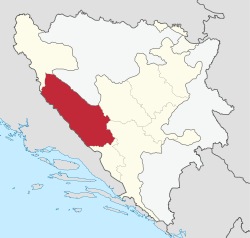
Back Cantón 10 AN كانتون 10 Arabic Кантон 10 Byelorussian Герцагбасанскі кантон BE-X-OLD Херцегбосненски кантон Bulgarian Kanton 10 BS Cantó 10 Catalan Hercegovačko-Bosanski Kanton CEB Kanton 10 Czech Kanton 10 German
This article needs additional citations for verification. (August 2021) |
Canton 10 Canton 10 | |
|---|---|
 | |
| Status | Canton of the Federation of Bosnia and Herzegovina |
| Capital | Livno (executive) Tomislavgrad (legislative) |
| Largest city | Livno |
| Official languages | CroatianSerbianBosnian |
| Ethnic groups (2013[1]) | 77.05% Croats 13.01% Serbs 9.58% Bosniaks |
| Government | Parliamentary system |
• Premier | Ivan Vukadin (HNP) |
• President of Assembly | Jozo Ćosić (HDZ 1990) |
| Legislature | Assembly of Canton 10 |
| Canton of the Federation of Bosnia and Herzegovina | |
• Establishment | 12 June 1996 |
| Area | |
• Total | 4,934.9 km2 (1,905.4 sq mi) |
| Population | |
• 2013 census | 83,844 |
| GDP (PPP) | 2022 estimate |
• Per capita | USD 14.983 |
| GDP (nominal) | 2022 estimate |
• Total | USD 155.642 Million |
• Per capita | USD 5.762 |
| HDI (2019) | 0.740 high |
| Currency | BAM |
| Time zone | UTC+1 (CET) |
• Summer (DST) | UTC+2 (CEST) |
| Date format | dd-mm-yyyy |
| Drives on | Right |
Website vladahbz | |
Canton 10 (Croatian: Herceg-Bosanska županija, lit. 'Herceg-Bosnia County', Serbian: Кантон 10, Bosnian: Kanton 10) is one of the ten cantons of the Federation of Bosnia and Herzegovina, a political entity of Bosnia and Herzegovina. It is the largest canton by area and eighth by population. The local government seat is in Livno, while the assembly is in Tomislavgrad. It is divided into five municipalities: Bosansko Grahovo, Drvar, Glamoč, Kupres, Tomislavgrad and one city, Livno.
The canton was established in 1996, following the Washington Agreement of 1994, which ended the Croat-Bosniak War. The majority of the population is ethnically Croat, living in the southern part of the canton, while the second-largest Serbs live in the northern part.
During the Bosnian War, the Croatian Defence Council (HVO) controlled the southern parts of the canton, while other parts, mostly in the north, were controlled by the Serb Army of Republika Srpska until 1994 when they were re-taken by the HVO with the support from the Croatian Army. Per the Washington Agreement, the territories were incorporated into the Croat-Bosniak Federation of Bosnia and Herzegovina. From 1996 to 2005, only Croats and Bosniaks were considered to be constituent nations within the canton, but since 2005, the Serbs are included among the constituent nations as well and are mentioned as such before the less numerous Bosniaks.
- ^ Sarajevo, juni 2016. CENZUS OF POPULATION, HOUSEHOLDS AND DWELLINGS IN BOSNIA AND HERZEGOVINA, 2013 FINAL RESULTS (PDF). BHAS. Archived from the original (PDF) on 24 December 2017. Retrieved 30 June 2016.